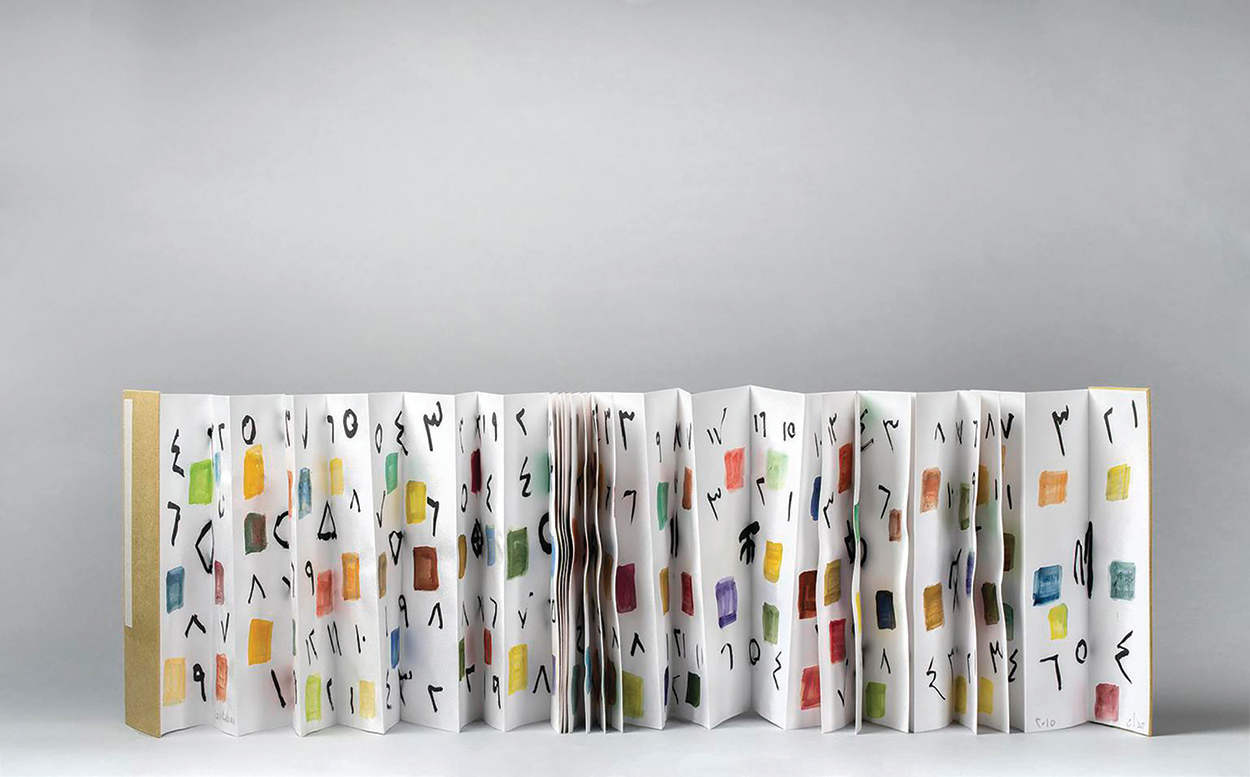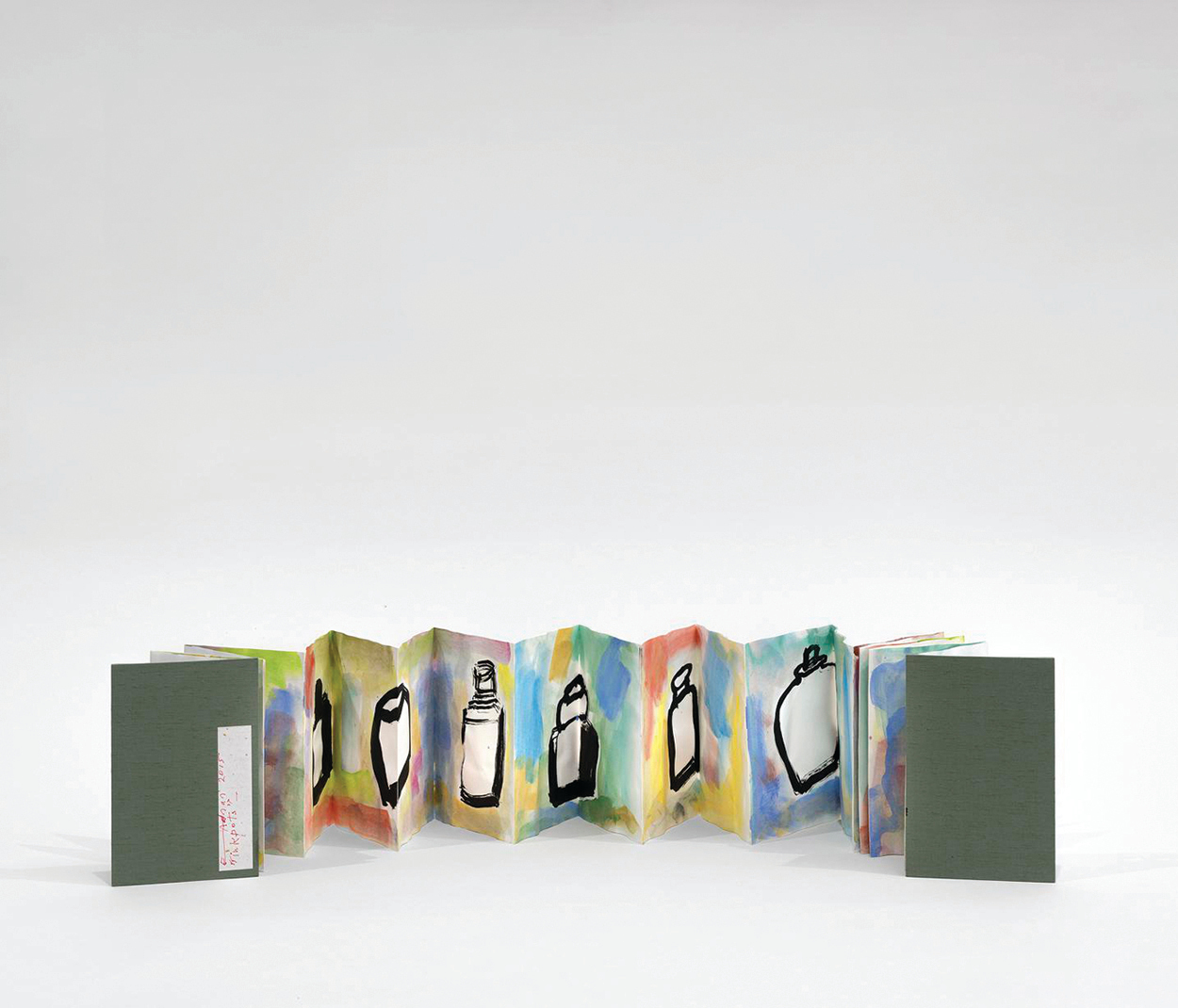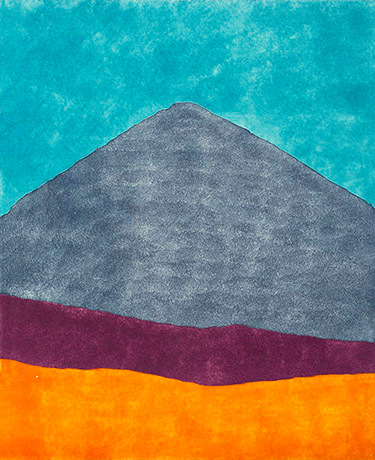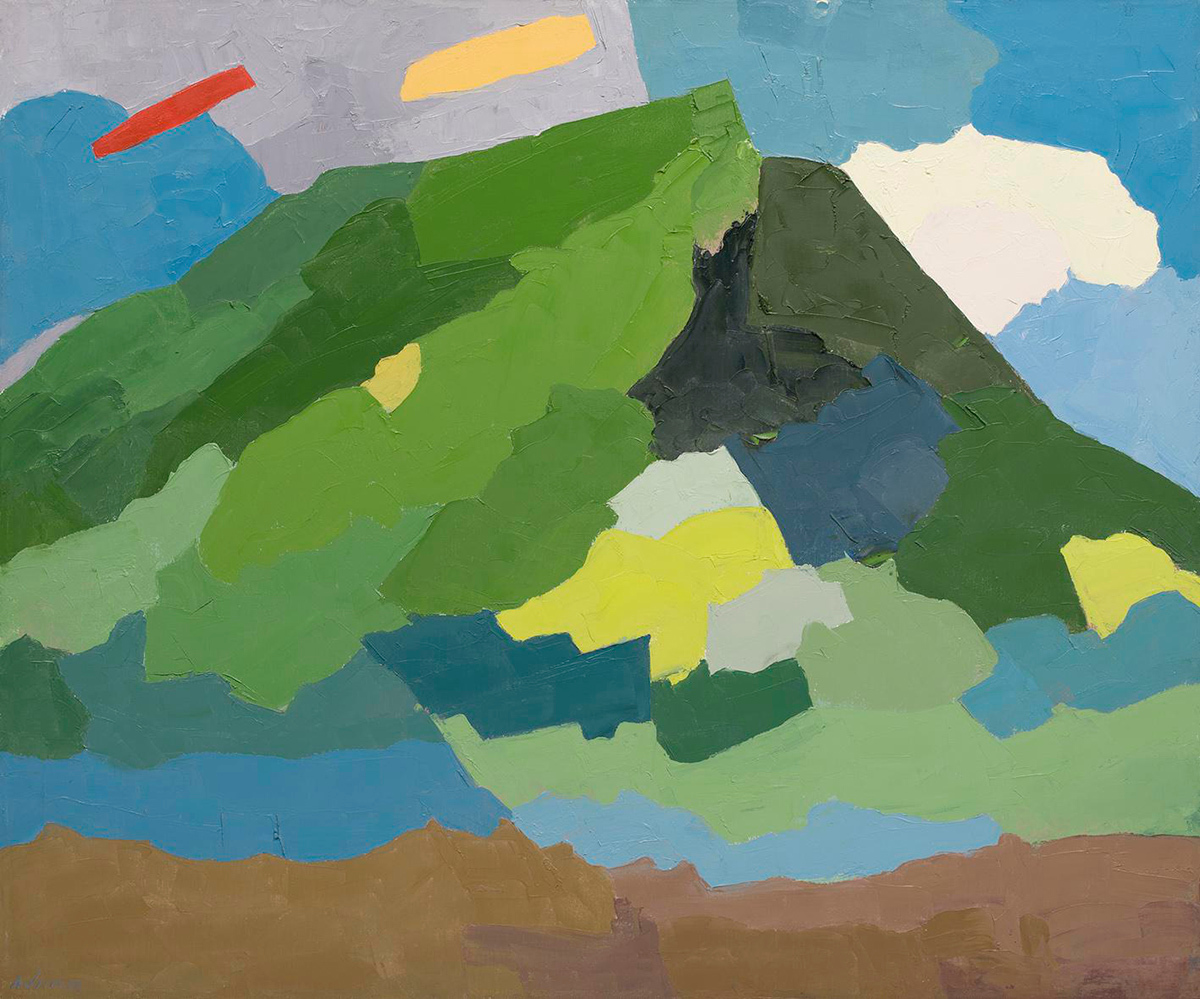 Etel Adnan: Mount Tamalpais, 1970/2017, wool tapestry, 63 by 78¾ inches. Courtesy Galerie Lelong & Co.
Etel Adnan: Mount Tamalpais, 1970/2017, wool tapestry, 63 by 78¾ inches. Courtesy Galerie Lelong & Co.
Etel Adnan’s contribution to the 2015 Istanbul Biennale was an artist’s book titled Family Memoirs on the End of the Ottoman Empire. This accordion-fold work contains the artist’s handwritten recollections, in Turkish and English, concerning her family and the catastrophic conflicts of the decade before her birth in 1925. As the text mentions politically sensitive material—social ties between Turkish and Armenian families before the 1915–17 Armenian-Assyrian-Greek Genocide—what had originally been foreseen as an accompanying wall text was shrunk down to a more discreet card one could read while viewing the turning of the pages. At the Biennale, a white-gloved assistant seated at a table silently lifted, displayed, and shifted the pages for visitors.
Family Memoirs on the End of the Ottoman Empire is but one example of Adnan’s sensitivity to the ways in which we look, read, and remember—a sensitivity that inflects her larger hybrid art-and-writing practice. In this particular institutional and national context, the fold took on new meaning, as a site that at once concealed and revealed, that demanded intimate, patient reading and looking from those who chose to approach the table, even as it intensified more broadly resonant connections between everyday life and the centenary of the genocide, still unacknowledged by the Turkish government.
Adnan, who was born in Beirut to a Syrian father and Greek mother, began working as a Californian in the late 1950s. After studying literature and philosophy at the École des Lettres in Beirut, the Sorbonne, the University of California at Berkeley, and Harvard, she became a professor at Dominican College of San Rafael in 1958, teaching aesthetics and the philosophy of art. There, a colleague encouraged her to revisit a childhood curiosity—painting—in spite of the fact that Adnan’s mother had warned her that she was “too clumsy.” (“And you believed her?” countered the colleague, artist Ann O’Hanlon.)
 Etel Adnan: Numbers, Signs and Squares, 2015, ink and watercolor on paper, approx. 13½ feet long. Courtesy Galerie Lelong & Co.
Etel Adnan: Numbers, Signs and Squares, 2015, ink and watercolor on paper, approx. 13½ feet long. Courtesy Galerie Lelong & Co.
Adnan began painting, wrote poetry in English against the war in Vietnam, and undertook an exploration of various media that would lead her to pursue tapestry-making and ceramics, filmmaking, fiction, playwriting, and journalism. Yet, to call Adnan’s path a “career” seems inaccurate: the term conversation is more apt. This conversation encompasses mountains, especially Mount Tamalpais, which she painted daily while residing in Sausalito, where it was visible from a window in her home; cities; wars; space exploration; the worlds of plants and animals; even the nature of color itself, in all its insistence, violence, and richness—and, of course, books.
THE NAME FOR THE ARTIST’S BOOK-FORM favored by Adnan has a somewhat ignominious source: in Mozart’s Don Giovanni, Leporello, the lothario’s right-hand man, reads out a list of his master’s amorous conquests. Famously, he sings, “My dear lady, this is a list of the beauties my master has loved; a list which I have compiled; observe and read along with me.” The leporello—an accordion-style binding with hard covers on either end—is so named for its resemblance to that character’s apparently endless list. With pages formed by a single folded sheet, the leporello can be conveniently packed up, its front cover like the top of a box. Yet one might unfold a long leporello to find that it crosses the entire floor of a room. A shorter leporello will stand nicely on a table top, like a small screen or series of walls, its zigzag pages and stiff covers acting as a sort of paper architecture.
 Etel Adnan: Inkpots, 2015, ink and watercolor on paper, approx. 91/2 feet long. Courtesy Galerie Lelong & Co.
Etel Adnan: Inkpots, 2015, ink and watercolor on paper, approx. 91/2 feet long. Courtesy Galerie Lelong & Co.
Adnan’s interrelated roles as poet and painter meet in these hybrid visual spaces that un-scroll in time. She makes use of blank accordion style books imported from Japan. The covers on either end of the book are wrapped with fabric by the manufacturer; sometimes the fabric is patterned or bears a pasted-on paper label. Adnan occasionally paints over the pattern or inscribes the title of the leporello on the label; otherwise, she does not alter the books before filling their pages. Of her decision to engage with this sort of prefabricated notebook, Adnan writes:
I remember how carefully I used to wash my hands, with what care and apprehension I was choosing a particular scroll, with what interest I was looking at the paper, usually Japanese handmade paper or rice paper made in Kyoto, because everything had to be in tune, the size, the format, the text, the colors, the texture of these colors, the light outside, my own availability; it was each time like entering into a religion for a believer, like going for a climb, for an alpinist, as if painting in this case was also a sacred sport, a battle both spiritual and physical, as well as a game of chance.
It is interesting to read Adnan’s use of the term “scroll” here. Although the pages of the leporello arrive already pleated, Adnan is clearly of a mind to emphasize their continuity rather than their possible status as a series of discrete rectangular planes, divided into units by line-like folds. At times, she continues handwriting or drawing, ignoring the folds altogether and ending only when she has filled the entire book. The tactility of the paper is as important as this quality of expansiveness. In mentioning her practice of adjusting her own “availability” to her materials and environment, Adnan’s remarks are reminiscent of those made by the Japanese novelist Junichiro Tanizaki in his 1933 essay, a favorite of students of design, In Praise of Shadows. Tanizaki notes, “Western paper turns away the light, while our paper seems to take it in to envelop it gently.” He observes that Japanese paper is soundless when agitated and “pliant to the touch.” This tendency to absorb and bend is at once inviting and challenging. Adnan says that to paint and write on “these long horizontal scrolls” is akin to the adoption of a system of belief or an encounter with a landscape; it is a “sacred sport,” a matter neither purely of the spirit nor of the body. Chance, presumably because of the liquid nature of ink as well as the undulating surface of the page, enters into this encounter as well. Materials, Adnan maintains, “become in a way a co-author of one’s work.”
The leporellos entail a sense of rhythm, of variation and call and response. Adnan works with her own improvisational gestures, refusing the notion of the mistake in favor of the happy error. In her essay “The Unfolding of an Artist’s Book,” from which I draw the remarks above, first published in 1998 in the journal Discourse, she writes, “The mind never rests on these scrolls as it moves back and forth on them as a scanner.” She maintains that the books “awake[n] . . . memory images, or memories of the nomadic essence of the spirit.” In these volumes, she is able to mingle handwritten text, drawings, and watercolors without engaging in acts of “illustration.” Rather, she is a translator: “Written words and the visual text mirror each other and form a new entity which combines them both.” In addition, Adnan’s interactions with folding books reveal to her the interpretative nature of perception itself: “Any thought that we may think to be primary, primordial, spontaneous is already an interpretation of something which precedes it.”
Also in her 1998 essay, Adnan tells the story of her friendship with an American artist and war veteran, Rick Barton. Adnan calls her exchange with Barton “a mystic transfer, a gesture in the logic of Being, something that came from a place preceding him and that had to go, to keep going.” When Adnan first met Barton in San Francisco, he was surviving on very little money, a pension from his service, and frequenting cafés in order to have a space to work that was not the small rented room where he lived. He was apparently a habitual user of opium and an avid reader, someone who devoted his life to small ink drawing —fragmentary portraits of café-goers—that he made in leporellos. Barton shared his work with Adnan and in the early 1960s presented her with a leporello he had begun to illustrate with faces and which she was meant to finish. Thus began the leporello chapter in Adnan’s devotion to the dialogue between language and pictures.
 Etel Adnan: Marin County, 2018, ceramic, 14½ by 11¾ inches. Courtesy Galerie Lelong & Co.
Etel Adnan: Marin County, 2018, ceramic, 14½ by 11¾ inches. Courtesy Galerie Lelong & Co.
ALTHOUGH, AS I HAVE NOTED, ADNAN BEGAN painting in the 1960s, her work was not broadly recognized in visual art circles until 2012, when curator Carolyn Christov-Bakargiev included her in Documenta 13. Later, Adnan’s participation in the 2014 Whitney Biennial brought even wider acclaim. Here, Stuart Comer curated a floor devoted to intermedia artworks and other practices exploring the relationship between print and visual art, including several of Adnan’s leporellos. For serious readers of Anglophone and Francophone poetry, Adnan was already a figure of renown who had published groundbreaking work in multiple genres in the late 1970s and ’80s. I myself began reading her poetry as a college student in 2002 or so and was astonished, twelve years later, visiting the Whitney, to learn that she was also considered a major painter and creator of artist’s books.
Literary writing and visual works inform one another and interpenetrate in Adnan’s practice. Adnan has, for example, always applied oil pigments straight from the tube using a palette knife, itself not unlike a broad pen nib. And, as the critic Kaelen Wilson-Goldie has observed, Adnan’s preferred canvases are “small, intimate, on the scale of a book.” The notion of writing hovers over Adnan’s painting practice, in which she makes her pieces, as Wilson-Goldie writes, using a semi literary method—“in a single sitting, working fast on a flat table, never on the wall or at an easel.” Meanwhile, Adnan’s writing partakes of the painterly; her poems are vivified with references to “red waters,” the “pleated horizon,” “shined surfaces,” and the light and heat of many colored suns, matter and landscapes that tremble on the verge of transformation into vivid two-dimensional images but which refuse to be flattened.
In Adnan’s more painterly leporellos, the zigzag surface is crammed full with seductive lines, sometimes in black ink only and at other times involving rich washes of color. A frequent subject is the artist’s desk, where potted flowering plants, vessels containing fruits, books, jars of ink, and writing implements predominate, as in 1989’s Sausalito, California, and the multiple “Inkpots” books of 2015. If the work in question was created in California, as with Spring (2003), a leporello depicting a series of flowerpots, the humped triangle of Mt. Tamalpais, with its distinct ridges, may be present in the background. The objects, plants, and landscapes of Adnan’s figurative scrolls all have a quiet, uncannily lifelike quality, as if they were gazing back at the artist, affirming her presence. The organization of these familiar items across folds additionally gives the leporello a nearly linguistic sort of revelatory energy, begging to be read from left to right when stretched; the work’s planes seem to cry out, “And then! And then! And then!” Or, perhaps, “Here! Here! Here!”
Elsewhere, Adnan arranges symbols and geometric shapes in patterns that resemble illuminated poetry without ever fully entering the semantic realm; these leporellos have a somewhat more recessed, erudite quality. One wants to linger over them, pausing on each character of the partly invented yet nearly intelligible hybrid alphabet or syllabary Adnan has devised for the occasion of a given artwork, attempting to read it aloud. Such books include Signes (2015) and Signs (2018), in which black “O”s, “X”s, crosses, and dots flirt with shapes approximating Greek letters, as well as Numbers, Signs and Squares (2015), in which numbers in Arabic dance with Greek letters and a variety of bright watercolor squares.
And there are the scrolls containing hand-copied poems written by friends and admired poets in Arabic, English, and French. (Among the American poets so treated are Barbara Guest, Lyn Hejinian, and Lawrence Ferlinghetti.) These pieces are often the most colorful and various, with bright passages in the shapes of hillsides or geometric forms and loose lines, as with Adonis (1984). Adnan’s partner, artist and publisher Simone Fattal, has written in the 2002 essay “On Perception: Etel Adnan’s Visual Art” that Adnan’s leporellos of illuminated poetry are especially poignant and urgent, as their words were “seen by Adnan twice, once as text and once as image.” Adnan, who grew up speaking Arabic but never learned to write the language in an academic context, effects a quiet “revolution in Arabic calligraphy,” Fattal maintains, by means of her highly personal act of recopying by hand.
 Etel Adnan: Signs, 2018,ink on paper, 80 inches long. Courtesy Galerie Lelong & Co.
Etel Adnan: Signs, 2018,ink on paper, 80 inches long. Courtesy Galerie Lelong & Co.
“I WRITE WHAT I SEE; I paint what I am,” Adnan wrote in her 1986 essayistic daybook, Journey to Mount Tamalpais, which contains an account of her painting practice. “To each place, there is a counter place,” she notes. This pronouncement leads to a comparison of the mountain in the title with Yosemite Valley, height contrasted with depth, aridity with greenness. Elsewhere in the piece, Adnan observes, “I feel trapped in this universe and think of what an anti-universe could mean, which is still a universe; there is no way out.” In a 2009 interview published in Bidoun, she told novelist Lynne Tillman that “I don’t lie when I write.” Adnan explains: “Something happens, and I must discover it. Writing forces one to go to the bitter end of what one thinks.” If there is something propulsive and urgent about the act of writing for Adnan, then perhaps painting provides a more restorative relationship to the line.
Images bear tremendous significance in Adnan’s novels and poetry, whether they serve as subjects and plot devices, or are incorporated into her sentences and lines as annotations in the form of glyphs. Adnan opens Sitt Marie Rose, her 1978 novel inspired by the kidnapping and murder of Marie Rose Boulos, a Lebanese teacher and pro-Palestinian activist, with a meditation on images. An unnamed female narrator is spending time with a wealthy man who shows her his latest amateur Super 8 film of a hunting trip in Syria and southeastern Turkey. The violence romanticized by these soft, grainy images soon spills over, in raw unmediated form, into the streets of Beirut with the commencement of the Lebanese Civil War.
Elsewhere, in what is perhaps her most brilliant work of poetry, The Arab Apocalypse (1989), Adnan’s linguistic writing transmogrifies into ink-drawn symbols—some legible, like suns, some more ambiguous, suggesting color-based notations—which intervene in otherwise relatively orderly lines of roman typeface. In this book of fifty-nine poems, which Adnan wrote at the beginning of the Civil War that raged from 1975 to 1990, there is a need for a form that engages the senses differently from written language and that can express her interrogation of conflict, whether internecine or civilizational. But by the time of this book’s publication Adnan had already been meditating on the book-form for several decades.
“THE ENVIRONMENT WAS MY LIFE,” Adnan said of her Beirut childhood in an interview with poet Lisa Robertson published in BOMB in 2014. In this conversation, Adnan speaks of the “great event” of light, that she saw the light in her sunny and sometimes partisan birth city as “a being on its own,” something to look at as well as to inhabit. The same might be said of the folds of her leporellos. She has written that these folds make possible “combinations of the same reality, the birth of different realities out of a single one.” The fold’s interior, French philosopher Gilles Deleuze wrote in 1988, is a space in which two planes approach each other until they meet in a brief hinge in which they become indistinguishable. There is no content in this hinge, save for the joining of the two planes; a fold is thus a no-man’s-land, in the most hopeful sense of that expression. A fold is utopian. It cannot be claimed for other use. (Try and you will end up with two torn pages and nothing where your fold was!)
But the utopia of the fold in Adnan’s work is not merely to be found in the physical manipulations of the page. It exists in the movement of the palette knife lavishing paint on canvas and in the intensity of the linguistic image in a line of poetry, or in the turn indicated by a comma in a sentence. For those of us who feel “trapped in this universe,” Adnan offers not so much an escape as a key to the unlimited potential inherent in the apparently humble present. “I see infinite distances between any point and another,” she writes in “Sea,” a long prose poem published in 2012. “That’s why time has to be eternal.” Adnan’s artist’s books, her leporellos, dip into the seam of the fold, a shady counter-place rich with thinking. They emerge again to get on with the story, a tale that now seems unending, for what is an ending, anyway, if not another fold?
This article appears under the title “Of Light & Folds” in the July/August 2021 issue, pp. 46–53.
Source link : https://www.artnews.com/art-in-america/features/etel-adnan-painting-poetry-artist-books-1234601190












